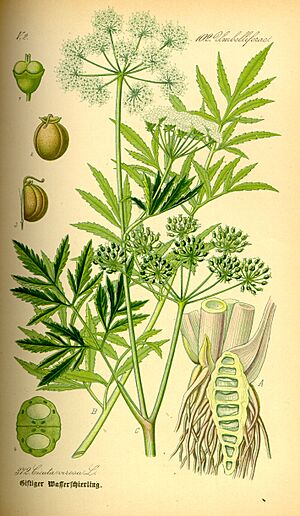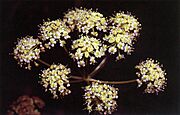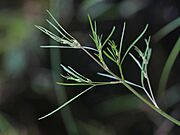Cicuta facts for kids
Quick facts for kids Cicuta |
|
|---|---|
 |
|
| Cicuta virosa | |
| Scientific classification |
|
| Kingdom: | Plantae |
| Clade: | Tracheophytes |
| Clade: | Angiosperms |
| Clade: | Eudicots |
| Clade: | Asterids |
| Order: | Apiales |
| Family: | Apiaceae |
| Subfamily: | Apioideae |
| Tribe: | Oenantheae |
| Genus: | Cicuta L. |
| Type species | |
| Cicuta virosa |
|
| Species | |
|
|
Cicuta, often called water hemlock, is a group of four very poisonous plant species. They belong to the Apiaceae family, which also includes carrots and parsley. These plants are perennials, meaning they live for more than two years. They can grow quite tall, up to about 8 feet (2.5 meters).
Water hemlock plants have small green or white flowers that grow in a special umbrella shape. You might also hear them called cowbane or poison parsnip. They are found in cooler parts of the Northern Hemisphere, like North America and Europe. You'll usually see them in wet places, such as wet meadows, near rivers, or in marshy areas.
It's easy to confuse water hemlock with other plants in the same family, some of which are safe to eat. But water hemlock is one of North America's most dangerous plants. It contains a strong toxin called cicutoxin. This toxin affects the brain and can cause seizures if someone eats even a small part of the plant. If someone is poisoned, they need urgent medical help. Doctors might use special medicine to stop the seizures and help the person breathe.
Contents
What Does Water Hemlock Look Like?
Water hemlock plants are biennials, meaning they live for two years. They all look quite similar. They can grow up to 8 feet (2.5 meters) tall. The stem is usually straight, smooth, and hollow. Sometimes it has purple stripes or spots, especially in the C. maculata species.
At the bottom of the stem, there's a thick, tuberous root that looks like a bunch of small carrots. This root has many chambers and contains a yellowish, oily liquid. When this liquid touches the air, it turns reddish-brown and smells a bit like raw parsnip.
The leaves grow in an alternating pattern along the stem. They are divided into many smaller leaflets, making them look like fern leaves. Each leaflet is long and narrow with sharp, saw-like edges. The leaves can be up to 3 feet (90 cm) long.
Water hemlock flowers in spring or early summer. The flowers are small and can be green or white. They grow in a distinctive umbrella shape, which is common for plants in this family. These flower clusters are about 2 to 4 inches (5-10 cm) wide. After flowering, the plant produces small, cylinder-shaped fruits, about 0.16 to 0.24 inches (4-6 mm) long. The plant spreads mainly through these small seeds, which it produces in large numbers.
-
Cicuta douglasii, showing its umbrella-shaped flowers
Water Hemlock in the Plant Family
The Cicuta group is part of the large family called Apiaceae. This family is also known as Umbelliferae. Both names are allowed by plant naming rules. Before the 1500s, people in Europe didn't always tell the difference between Cicuta and a similar plant called Conium.
The famous scientist Carl Linnaeus officially described three species of water hemlock in 1753. The main species that represents the group is Cicuta virosa. Today, we recognize four main species:
| Species Name | Common Name |
|---|---|
| Cicuta bulbifera L. | Bulblet-bearing water hemlock |
| Cicuta douglasii (DC.) Coult. & Rose | Douglas water hemlock, Western water hemlock |
| Cicuta maculata L. | Spotted cowbane, Spotted water hemlock |
| Cicuta virosa L. | Cowbane, Northern water hemlock |
Some older names for water hemlock, like Cicuta bolanderi or Cicuta californica, are now considered to be just different types or varieties of the widespread Cicuta maculata. Other general names for water hemlock include beaver poison, wild carrot, and false parsley.
Plants That Look Like Water Hemlock
Many plants in the Apiaceae family look very similar, which can make it hard to tell them apart. Water hemlock is often mistaken for edible plants like wild celery, regular celery, wild carrot, or wild parsnip.
One common mistake is confusing water hemlock with water parsnip. Both have clusters of small white, umbrella-shaped flowers and grow near lakes and rivers. However, there are some key differences:
- Water parsnip leaves are only divided once, while water hemlock leaves are divided two or three times.
- Water hemlock has a large swelling at the base of its stem, which water parsnip does not have.
- Water hemlock has small leaf-like structures (called bracts) only at the base of the smaller flower clusters, not at the base of the main flower head. Water parsnip has bracts in both places.
Also, people sometimes confuse water hemlock (Cicuta) with poison hemlock (Conium maculatum), because they share the name "hemlock." Both are poisonous. You can tell them apart by their roots: water hemlock has branched roots with small tubes, while poison hemlock has a single main root.
A very reliable way to identify water hemlock is to look closely at its leaf veins. Unlike most other plants in this family, water hemlock's leaf veins end in the notches between the leaf tips, not at the very tip of the leaf.
Where Water Hemlock Grows
Cicuta species are found across North America and Europe. They typically grow in very wet places, like next to ponds and streams, in marshes, or in swampy areas that are wet for at least part of the year. You can even find them growing in water.
Of the four species, Cicuta maculata is the most widespread in North America. Cicuta bulbifera also grows across much of Northern North America. Cicuta douglasii is found in the northwest part of North America. Cicuta virosa grows in central and northern Europe (including the British Isles), northern Asia, and the far north of North America.
Why Water Hemlock is Dangerous
All parts of water hemlock plants contain high levels of a dangerous poison called cicutoxin. This toxin is present at all stages of the plant's growth. The roots are usually the most poisonous, especially in early spring.
Cicutoxin mainly affects the central nervous system, which includes your brain and spinal cord. It makes brain cells overly active, which can lead to seizures. Water hemlock is considered one of the most toxic plants in North America. Eating even a very small amount can be deadly for humans. There are records of severe poisoning and deaths from this plant going back to the 1600s, and it continues to cause harm today.
People have been poisoned by water hemlock in various ways. For example, children have become sick after blowing whistles made from the hollow stems. There have even been cases where people got sick just from touching the plant and rubbing it on their skin.
Livestock, like cows, are often affected, which is why the plant is sometimes called "cowbane." Animals often eat the roots when the ground is soft in spring, pulling up the whole plant. Roots exposed by farming can also cause poisoning in animals. An animal can die from eating the plant in as little as 15 minutes.
What Happens if Someone is Poisoned?
If a person or animal eats water hemlock, the main symptom is usually seizures. These can start very quickly, sometimes within 15 minutes. At first, someone might feel sick to their stomach, throw up, have belly pain, or feel dizzy and confused. But often, seizures are the very first sign.
Ongoing seizures can cause other serious problems, like a very high body temperature, swelling in the brain, and muscle damage. Other signs might include seeing or hearing things that aren't there, tingling skin, or very wide pupils. The heart rate and blood pressure can also go up and down. People might also have trouble breathing.
Death usually happens because of breathing problems or severe heart issues caused by the seizures. Fatalities can occur within a few hours of eating the plant. If someone survives, they usually get better within 24 to 48 hours, though seizures can last longer. Sometimes, people have long-term effects like memory loss about the poisoning, or they might feel restless or have muscle weakness for months afterward.
How Poisoning is Treated
Doctors usually suspect water hemlock poisoning if someone has eaten the plant and then suddenly has seizures. There are special lab tests to find cicutoxin in the blood, but these are not usually done in regular hospitals. If a piece of the plant was saved, a plant expert can identify it to confirm the diagnosis.
The first step in treatment might be to give activated charcoal to help stop the body from absorbing more of the poison. This is usually done soon after the plant was eaten. There is no specific medicine that cures water hemlock poisoning. Instead, doctors focus on supportive care, which means treating the symptoms.
The most important part of treatment is controlling the seizures. Doctors use medicines called benzodiazepines, like lorazepam or diazepam, to stop the seizures. If those don't work, stronger medicines might be used. Because these medicines can make it hard to breathe, patients might need help breathing with a machine. Doctors will also watch brain activity closely.
Other problems caused by the poisoning, like high body temperature or low blood pressure, are also treated. For example, low blood pressure is often treated with fluids given through a vein.
See also
- List of poisonous plants






